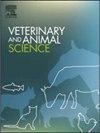Synergistic interplay of Azadirachta indica and Curcuma longa improves feed efficiency and ω-6 fatty acid content in the breast muscle of broiler chicken
IF 1.9
Q2 AGRICULTURE, DAIRY & ANIMAL SCIENCE
引用次数: 0
Abstract
The study explores synergistic interplay of Azadirachta indica and Curcuma longa to address the current gap of suboptimal feed conversion ratio and inadequate enrichment of ω-6 fatty acids (FAs) in the breast muscle of the broiler chicken. Total 288 Ross-308 male broiler chicks were randomly distributed in a complete block design at 2 × 3 (Two different phytochemicals, i.e., A. indica, and C. longa at three different levels, i.e., 0, 0.063, and 0.125 % of the basal diet) factorial arrangement. Final live weight (FLW), average daily feed intake (ADFI), average daily gain (ADG), feed conversion ratio (FCR), carcass characteristics, cardio-pulmonary morphometry, haemato-biochemical indices, gut morphology, ileal nutrient digestibility, tibia morphometry, meat quality and FA profile were measured. Results indicated that, supplementation of A. indica leaf meal (AILM) improved 6.0 % FCR (P < 0.001), 35.9 % tibia calcium content (P = 0.007) and 9.6 % of the digestibility of CP (P < 0.001) at the expense of 14.9 % FLW (P < 0.001), 20.6 % ADFI (P < 0.001), 15.1 % ADG (P < 0.001), and 16.0 % right to total ventricular ratio (P = 0.022). Accordingly, C. longa powder (CLP) improved 2.1 % FCR (P = 0.021) at the expense of 5.9 % FLW (P = 0.031), 7.6 % ADFI (P < 0.001) and 5.3 % ADG (P = 0.017). The AILM substantially increased 52.4 % UFA (P < 0.001), 58.2 % MUFA (P = 0.005), 38.7 % ∑PUFA (P = 0.046), 41.7 % ∑ω-6 FAs (P = 0.013) and decreased 24.3 % ∑SFA (P < 0.001). Similarly, the CLP increased 8.1 % ∑UFA (P = 0.022), 21.6 % ∑PUFA (P = 0.015), 22.4 % ∑ω-6 FAs (P = 0.033) and decreased 4.3 % ∑SFA (P = 0.031). The AILM and CLP interacted to increase 35.3 % ∑UFA (P = 0.003) and to decrease 21.2 % ∑SFA (P = 0.008). It was concluded that A. indica and C. longa concomitantly improved FCR and meat quality without affecting gut morphology and haemato-biochemical indices of the broiler chicken.
印楝和姜黄的协同作用提高了肉仔鸡的饲料效率和胸肌中ω-6脂肪酸的含量
本研究旨在探讨印楝和姜黄的协同作用,以解决肉仔鸡胸肌中饲料转化率不理想和ω-6脂肪酸富集不足的问题。试验选用288只罗斯-308雄性肉鸡,采用2 × 3全区设计(2种不同植物化学成分,即籼稻和龙花,在基础饲粮中分别占0、0.063和0.125%)的因子组合。测定末活重(FLW)、平均日采食量(ADFI)、平均日增重(ADG)、饲料系数(FCR)、胴体特性、心肺形态、血液生化指标、肠道形态、回肠营养物质消化率、胫骨形态、肉品质和FA谱。结果表明,添加籼稻叶粕(AILM)可提高6.0%的FCR (P <;胫骨钙含量为35.9% (P = 0.007),粗蛋白质消化率为9.6% (P <;0.001),以14.9% FLW为代价(P <;0.001), ADFI为20.6% (P <;0.001),平均日增重15.1% (P <;0.001),右心室与总心室比16.0% (P = 0.022)。因此,龙骨粉(CLP)提高了2.1%的FCR (P = 0.021),而FLW提高了5.9% (P = 0.031), ADFI提高了7.6% (P <;0.001)和5.3% ADG (P = 0.017)。AILM大幅增加了52.4%的UFA (P <;0.001)、58.2%的MUFA (P = 0.005)、38.7%的∑PUFA (P = 0.046)、41.7%的∑ω-6 fa (P = 0.013)和24.3%的∑SFA (P <;0.001)。CLP提高了8.1%的∑UFA (P = 0.022)、21.6%的∑PUFA (P = 0.015)、22.4%的∑ω-6 fa (P = 0.033),降低了4.3%的∑SFA (P = 0.031)。AILM和CLP相互作用使∑UFA增加35.3% (P = 0.003),∑SFA降低21.2% (P = 0.008)。由此可见,在不影响肉鸡肠道形态和血液生化指标的情况下,印度曲菌和长曲菌可显著提高肉鸡的饲料效率和肉品质。
本文章由计算机程序翻译,如有差异,请以英文原文为准。
求助全文
约1分钟内获得全文
求助全文
来源期刊

Veterinary and Animal Science
Veterinary-Veterinary (all)
CiteScore
3.50
自引率
0.00%
发文量
43
审稿时长
47 days
 求助内容:
求助内容: 应助结果提醒方式:
应助结果提醒方式:


